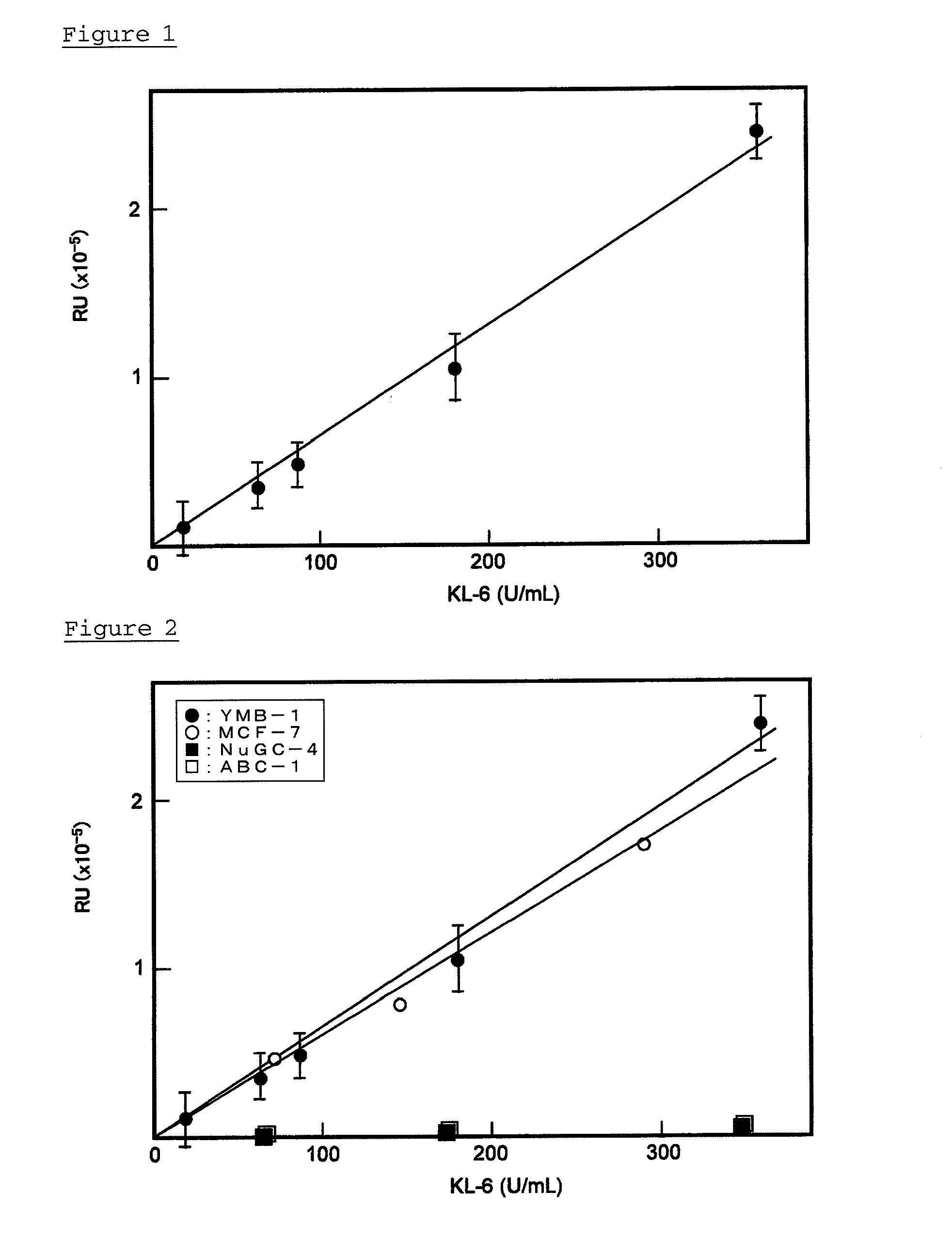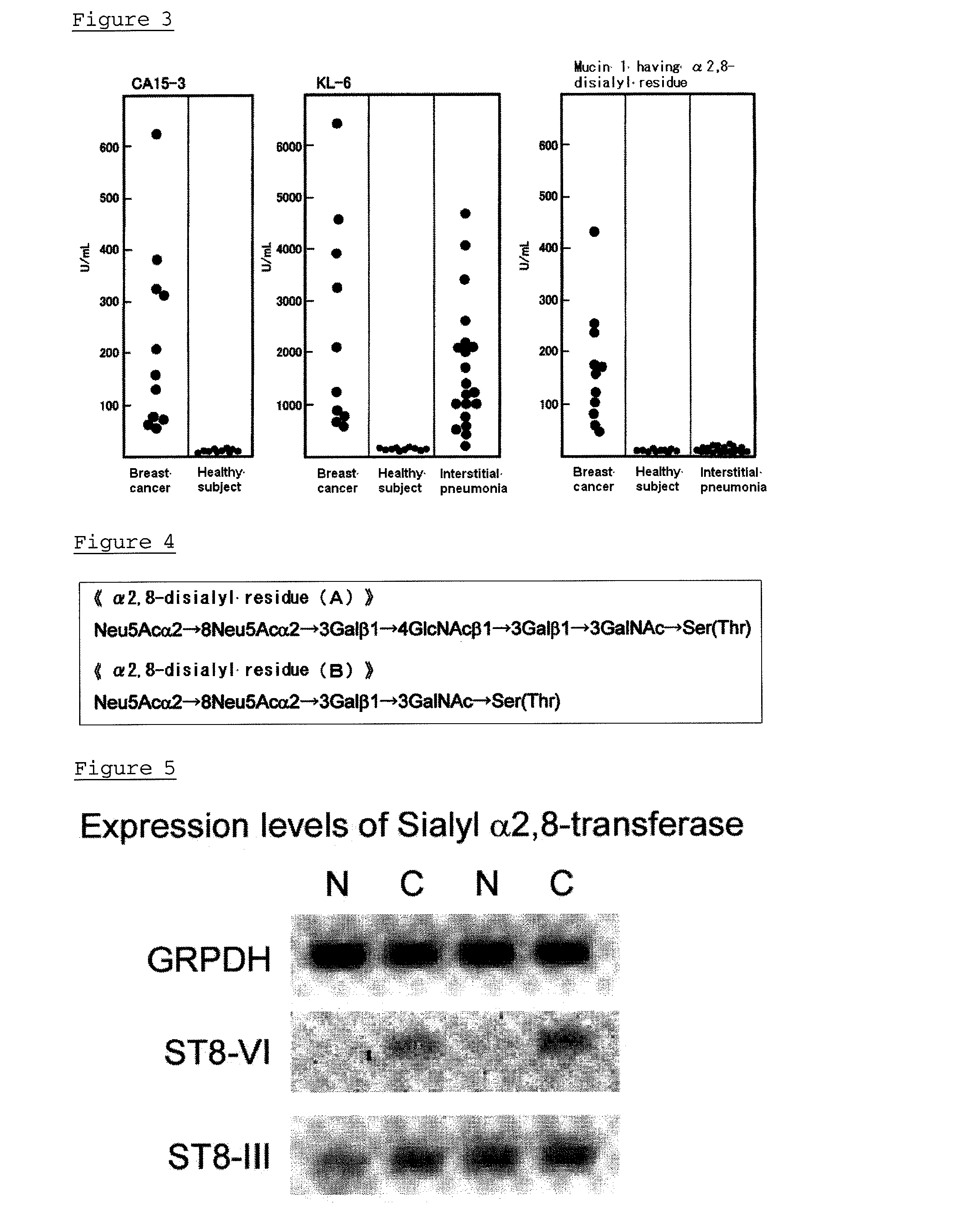Method for analyzing mucin 1 having siaalpha2-8siaalpha2-3galbeta glycans
a technology of siaalpha2-8siaalpha2-3galbeta glycan and mucin, which is applied in the field of method for analyzing sia28sia23galglycan, can solve the problems that metastasis or relapse of breast cancer, and the frequent interstitial pneumonia of breast cancer patients cannot be distinguished from the development of interstitial pneumonia
- Summary
- Abstract
- Description
- Claims
- Application Information
AI Technical Summary
Benefits of technology
Problems solved by technology
Method used
Image
Examples
example 1
Isolation of Mucin 1 having α2,8-Disialyl Residue
[0129]In this Example, mucin 1 having α2,8-disialyl residue was isolated and purified from a breast cancer cell line.
[0130]The breast cancer cell line YMB-1 (1×107 cells) was collected by centrifugation. 1 mL of an extraction buffer (50 mM Tris-HCl, 0.15M NaCl, pH8.0, 1.0% NP-40) was added to the collected cells and the cells were lysed by vigorous stirring. The resulting solution was centrifuged at 15,000 g for 15 minutes to collect a supernatant. 1 mL of the supernatant was applied to an affinity column with KL-6 antibody, which was equilibrated with the extraction buffer, and was stood for 30 minutes. The affinity column was washed with a 20-fold volume of the extraction buffer, and further washed with a 5-fold volume of PBS. Mucin 1 was eluted with 3 mL of an elution buffer (10 mM KH2PO4, 3M NaCl, pH2.5) to obtain a mucin 1 solution.
[0131]The above affinity column with KL-6 antibody was prepared by using CNBr—Sepharose (GEhealthca...
example 2
Construction of Measurement System of Mucin 1 Having α2,8-Disialyl Residue
[0132]In this Example, an immunological assay system for mucin 1 having α2,8-disialyl residue was constructed by a sandwich assay.
[0133]50 μL of a monoclonal antibody S2-566 diluted to a concentration of 1 μg / mL with PBS, was added to a 96-well black high-binding plate (Corning Inc., Corning, N.Y.), and was immobilized at 4° C. for 16 hr. The surface of each well was blocked with PBS containing 1% BSA at 25° C. for 1 hr. As a standard substance, the solution of YMB-1 mucin 1 having α2,8-disialyl residue obtained in Example 1 was diluted between 10 and 6000 times with a diluent wherein 1% BSA had been added to PBS-0.1% Tween-20 (PBS-T). Then, 50 μL of the diluted YMB-1 mucin 1 solution was added to the wells, and incubated at 25° C. for 2 hrs. After washing with PBS-T three times, 50 μL of KL-6 antibody diluted by a factor of 1000 was added and incubated at 25° C. for 1.5 hr. The wells were washed with PBS-T fo...
example 3
Measurement of Mucin 1 in Extract from Cancer Cell Lines
[0135]In this Example, expressions of mucin 1 having α2,8-disialyl residue in cancer cell lines other than breast cancer were examined.
[0136]The procedure described in Example 1 was repeated except that breast cancer cell line MCF-7, gastric cancer cell line NUGC-4, and lung cancer cell line ABC-1 were used instead of the breast cancer cell line YMB-1, to obtain MCF-7 mucin 1 solution, NuGC-4 mucin 1 solution, and ABC-1 mucin 1 solution. Mucin 1 having α2,8-disialyl residue in the above mucin 1 solutions were measured by the sandwich assay described in Example 2.
[0137]The results are shown in FIG. 2. In the mucin 1 solutions of the breast cancer cell line YMB-1 and the breast cancer cell line MCF-7, mucin 1 having α2,8-disialyl residue was detected. However, mucin 1 having α2,8-disialyl residue was not detected in the mucin 1 solutions of the gastric cancer cell line NUGC-4, and the lung cancer cell line ABC-1.
PUM
| Property | Measurement | Unit |
|---|---|---|
| volume | aaaaa | aaaaa |
| concentration | aaaaa | aaaaa |
| weight | aaaaa | aaaaa |
Abstract
Description
Claims
Application Information
 Login to View More
Login to View More - R&D
- Intellectual Property
- Life Sciences
- Materials
- Tech Scout
- Unparalleled Data Quality
- Higher Quality Content
- 60% Fewer Hallucinations
Browse by: Latest US Patents, China's latest patents, Technical Efficacy Thesaurus, Application Domain, Technology Topic, Popular Technical Reports.
© 2025 PatSnap. All rights reserved.Legal|Privacy policy|Modern Slavery Act Transparency Statement|Sitemap|About US| Contact US: help@patsnap.com


